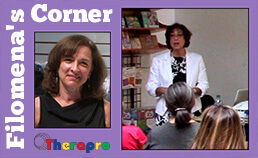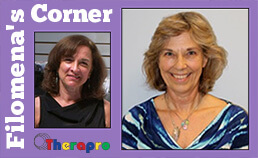
On August 24th, Therapro’s Saturday Seminar Series returned from summer hiatus with a timely and very well received presentation from Karen Hefler, OT, OTR, entitled Back to School Bootcamp! Karen is the owner/director of Rehabilitation Therapy Associates LLC, a Massachusetts pediatric occupational therapy private practice that serves schools by providing contract services, assessment services, direct therapy services, and consultation. Additionally, her company provides in-service training for academic staff and parents, program development and program evaluation. Additionally, Karen is the current president of the Massachusetts Association for Occupational Therapy (MAOT).
Karen’s expertise was evident in her practical and comprehensive presentation that covered a myriad of hot topics. The audience, comprised of occupational therapy practitioners, peppered her with questions, comments, and shared ideas and concerns throughout the 2+ hour seminar. She achieved the learning objectives she established for the seminar that included: 1) identifying strategies for setting up classrooms and inclusionary activities; 2) using occupational therapy appropriately with Response to Intervention; and 3) reviewing Common Core Standards and their application to occupational therapy.
Karen offered helpful hints to facilitate a smooth start to the new academic year. She recommended checking IEPs and 504s right off the bat to ensure they’re signed and state the correct service delivery. She also recommended meeting with the team versus meeting with each professional individually to maximize time and coordination of services.
By visiting classrooms at the start of the school year, OTs can check out the classroom environment and design, seating, and tools available to students such as paper, writing implements, scissors, fidgets, etc.
To maintain lines of communication with teachers and parents, Karen offered a number of creative ideas that result in “embedding” the OTs into the school environment. Suggestions included signed and shared consultation sheets, creating an OT web page, newsletter, or blog, and offering an OT “Tip of the week.”
Karen concisely yet thoroughly reviewed RtI (Response to Intervention), also known as multi-tiered systems of support (MTSS). It is an approach to service delivery that encompasses both general and special education that matches the student’s needs. For additional information, Karen referred to AOTA’s 2014 publication, Frequently Asked Questions (FAQ): Response to Intervention for School-Based Occupational Therapists and Occupational Therapy Assistants.
Reminding ourselves of the role of the occupational therapy practitioner in an educational setting is imperative! In summary, “School based occupational therapy services are not about remediation, but are about one’s ability to engage in education.” We truly appreciate the excitement and dialog generated by Karen’s seminar regarding the challenge of being a school-based occupational therapy practitioner!
Here are just a few of the many passionate responses from attendees at Karen’s seminar:
“The current practice information is very helpful. Thank you very much.” – Nancye K., Occupational Therapist
“So knowledgeable, flexible, well spoken and generous with info & resources! Thank you!” – Beth B., Occupational Therapist
“Karen did a wonderful job providing sound information to work “smarter not harder.” This workshop helped me understand my “why” and has brought a sense of clarity going into the school year! Thank you!” – Tara G., Occupational Therapist
“Extremely helpful!” – Elizabeth D., Occupational Therapist
Thank you, Karen!
Filomena Connor, OT, MS, OTR
August 24, 2019



